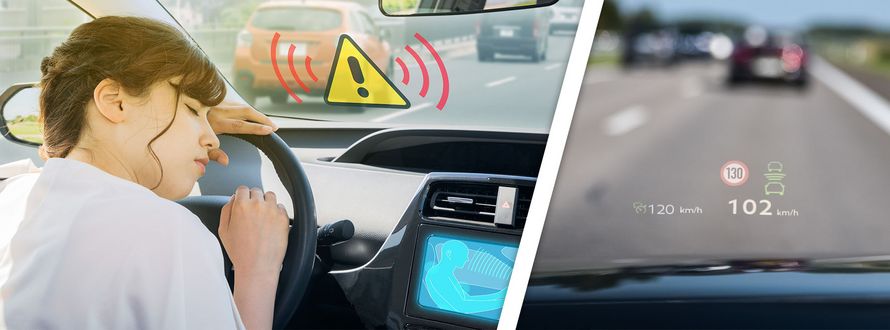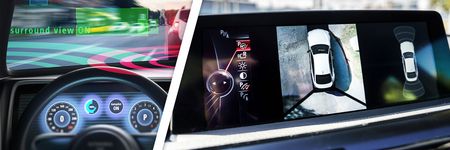
Beyond the Wheel: Exploring Intelligent Systems that Protect Drivers and Passengers
– Automotive, SafetyIn an era where technology seamlessly mixes together with everyday life, the automotive industry has paved the way for the integration of occupant and driver Information systems, leading to increased driver and road safety.
These sophisticated automotive assistants go beyond monitoring steering habits and driving times as they are designed to enhance the well-being of both drivers and passengers. From fatigue detection systems that prevent drowsy driving to occupant state recognition technologies ensuring alertness, these innovations stand as watchful assistants on the road. Furthermore, Car2X communication capabilities provide real-time warnings about potential hazards, while traffic sign recognition and emergency brake light systems actively contribute to accident prevention.
Systems for Occupant and Driver Information
Read more about powerful automotive assistants that create a safer and smarter driving experience for everyone on the road:
Fatigue Assistant
Whend riving on the road, the driver's steering and lane-keeping behavior are monitored, providing corresponding feedback through the interaction of vehicle sensors and external cameras. The duration of continuous driving without a timely break can also contribute to emerging fatigue and is thus additionally taken into account. The vehicle system displays a warning to the driver, potentially accompanied by an audible signal or steering wheel vibration.
Alerting the driver to impending fatigue could prevent a significant number of injuries and traffic fatalities. Expert estimates suggest that up to 30 % of accidents are attributable to fatigue and attention deficits. Often, drivers are unaware that they can no longer attentively control the vehicle. This can lead to microsleeps or even complete dozing off at the wheel, resulting in corresponding terrible accident consequences. Therefore, the system makes a crucial contribution to road safety and driving behavior.
Other terms for this system include Fatigue Warning, Fatigue Detection, Attention Assistant, Driver Drowsiness or Attention Warning.
Occupant State Recognition
To determine whether the driver is fully focused on driving, indirect control through steering movements and tracking of driving times is insufficient. Internal camera systems mostly monitor eye and head movements as well as blink frequency to detect emerging fatigue, distraction from the road or sudden deterioration of health (such as fainting).
The assistant is designed to autonomously attempt to wake the driver and, if necessary, safely bring the vehicle to a stop if the driver becomes unresponsive. Depending on the configuration, the system can also detect if occupants, such as children, are accidentally left in the vehicle. It can then warn the driver via smartphone or other devices or even alert emergency services in threatening situations.
Lack of attention and distraction are common causes of accidents on the road. Prolonged use of a touchscreen display or even a smartphone during driving results in significant reaction delays - every inattentive second on the road can be crucial. Additionally, there are instances where drivers suddenly fail to perceive the driving task. Therefore, this system plays a vital role in enhancing road safety.
Other terms for this system would be Occupant State Detection, Occupant Monitoring, Attention Assistant, Emergency Assistant, Occupant Status Monitoring (OSM), Driver Availability Monitoring Systems or Advanced Driver Distraction Warning.
Car-to-Car (C2C) Communication
Car-to-Car (C2C) Communication, also technically known as Vehicle-to-Vehicle (V2V) communication, involves the real-time exchange of information between vehicles using wireless technology, fostering enhanced safety features and road coordination.
Through a wireless connection, vehicles share warnings about hazardous situations, including obstacles, traffic jams, emergency braking, accidents, the presence of emergency vehicles, or adverse weather and road conditions. Utilizing vehicle positioning, this communication system swiftly informs directly affected parties, allowing drivers to proactively respond to unforeseen events, thereby bolstering overall road safety.
This technology plays a pivotal role in the journey towards automated driving, where vehicles need to intelligently and autonomously recognize diverse situations and ensure the safe transportation of occupants. Car-to-Car communication serves as a critical component, facilitating effective communication between vehicles and contributing to a safer and more coordinated road environment.
Traffic Sign Recognition
A camera in the vehicle's windshield captures and recognizes traffic signs such as speed limits, prohibitions, hazards, or right-of-way signs, displaying them on the vehicle's display. This informs the driver about the current applicable speed limit, no-passing zones, or right-of-way situations. If the driver does not respond accordingly, such as adjusting their speed, the icons on the display are highlighted. Additionally, warning sounds or steering wheel vibrations can also be executed to prompt the desired driving action.
The recognition and display of traffic signs on the vehicle's display remind the driver of existing speed limits and right-of-way situations, positively influencing road Safety. This is important as drivers may overlook a sign or forget its validity.
Emergency Brake Light
By processing current speed, pedal transition to the brake, and the intensity of braking, these assistants recognize emergency or full braking. Also, by assessing the traffic situation, the activation of the emergency brake assistant is a parameter for triggering the rapidly flashing brake light as a warning signal for following traffic.
Since every second counts in such situations, a rapidly flashing and bright brake light serves as a clear warning signal for the driver behind to initiate an immediate brake. It directly contributes to reducing rear-end collisions and the resulting injuries and fatalities. The mandatory introduction of such a system is planned and is easily achievable in conjunction with the emergency braking assistance system.
Other terms for this system include Emergency Stop Signal and Flashing Brake Light.
Emergency Call System (eCall)
The emergency call system, also known as eCall (Emergency Call), is a crucial component of modern vehicle technology aimed at quickly and efficiently summoning help in the event of an accident. Indirect control through steering movements is insufficient to ensure immediate assistance in emergency situations. The eCall system utilizes advanced communication technologies to automatically establish a connection to an emergency call center (Public Safety Answering Point, PSAP) in case of a serious accident.
At the moment of the accident, the eCall system automatically sends relevant information to emergency services. This includes data such as the exact location of the vehicle, the number of occupants, the time of the accident, and the direction of travel. By integrating GPS and other sensors, the system can provide precise information, significantly reducing the response time of emergency services.
Moreover, the eCall system enables direct communication between the occupants of the vehicle and the emergency call center. This is crucial to provide instructions to the occupants, offer reassuring words, or obtain essential information that may not have been automatically transmitted.
The automation of this emergency call system significantly contributes to minimizing response time in critical situations, thereby increasing the chances of survival for occupants. Especially in accidents where occupants are unable to make an emergency call themselves, eCall becomes a life-saving assistant on the road. The focus is on providing fast and accurate assistance in emergencies, thereby enhancing overall road safety.
How is SYSGO involved?
SYSGO is specialized in real-time operating systems (RTOS) and embedded system solutions. We provide software products for safety and security-critical applications, including those in the Automotive industry. Our products play a crucial role when it comes to software solutions designed for embedded applications such as driver assistance systems, occupant monitoring, Car2X communication, or emergency systems.
Here's how SYSGO's products can be valuable for automotive manufacturers:
Real-Time Operating System (RTOS): SYSGO provide real-time operating systems that ensures precise and predictable timing for critical functions in automotive applications. This is crucial for systems like driver assistance and monitoring applications, where timely and deterministic responses are essential.
Secure Hypervisor Technology: We offer secure hypervisor technology, like the PikeOS, which allows the separation of different functions within a single hardware platform. This can be relevant for ensuring the isolation of safety-critical functions from less critical ones, contributing to overall system safety and security.
Hypervisor Virtualization: The hypervisor implemented in automotive systems facilitates resource virtualization, enabling the concurrent operation of multiple guest operating systems (such as Android, Linux, or AGL) or guest partitions on a unified hardware platform.
Safety and Security Certification: SYSGO's products are designed to comply with safety and security standards such as ISO 26262 for functional safety and ISO 21434 for cybersecurity in automotive systems.
Communication Middleware: We provide streamlined and secure communication among diverse in-vehicle systems. Our solutions are tailored to enhance communication between distinct components housed within the vehicle's ECUs or between vehicles and infrastructure. The implementation of robust communication protocols is imperative to ensure the seamless operation.
Customizable Solutions: SYSGO offers customizable solutions that can be tailored to specific automotive applications. This flexibility allows automakers and suppliers to integrate our technology into their systems, meeting the unique requirements of different vehicle models and use cases.
SACoP - Secure Automotive Connectivity Platform
SACoP is our powerful platform that serves as a ready-to-use development platform and secure gateway for the automotive industry. It focuses on deterministic response times, ensuring safety through real-time operating systems. The platform integrates a robust gateway with firewall and intrusion detection, enhancing vehicle safety and preventing unauthorized access. Virtualization allows easy integration of new features, maintaining stability amid evolving user demands. Utilizing PikeOS, SACoP excels in determinism, real-time capabilities, security, safety, and virtualization, ensuring optimal performance. The architecture prioritizes secure inter-partition communication, emphasizing network security and adaptability to diverse connectivity needs.
More information at www.sysgo.com/sacop
---
More information at www.sysgo.com/pikeos
More information at www.sysgo.com/elinos
-
Previous
-
Next

 Twitter
Twitter LinkedIn
LinkedIn Facebook
Facebook Reddit
Reddit RSS
RSS Copy link
Copy link
